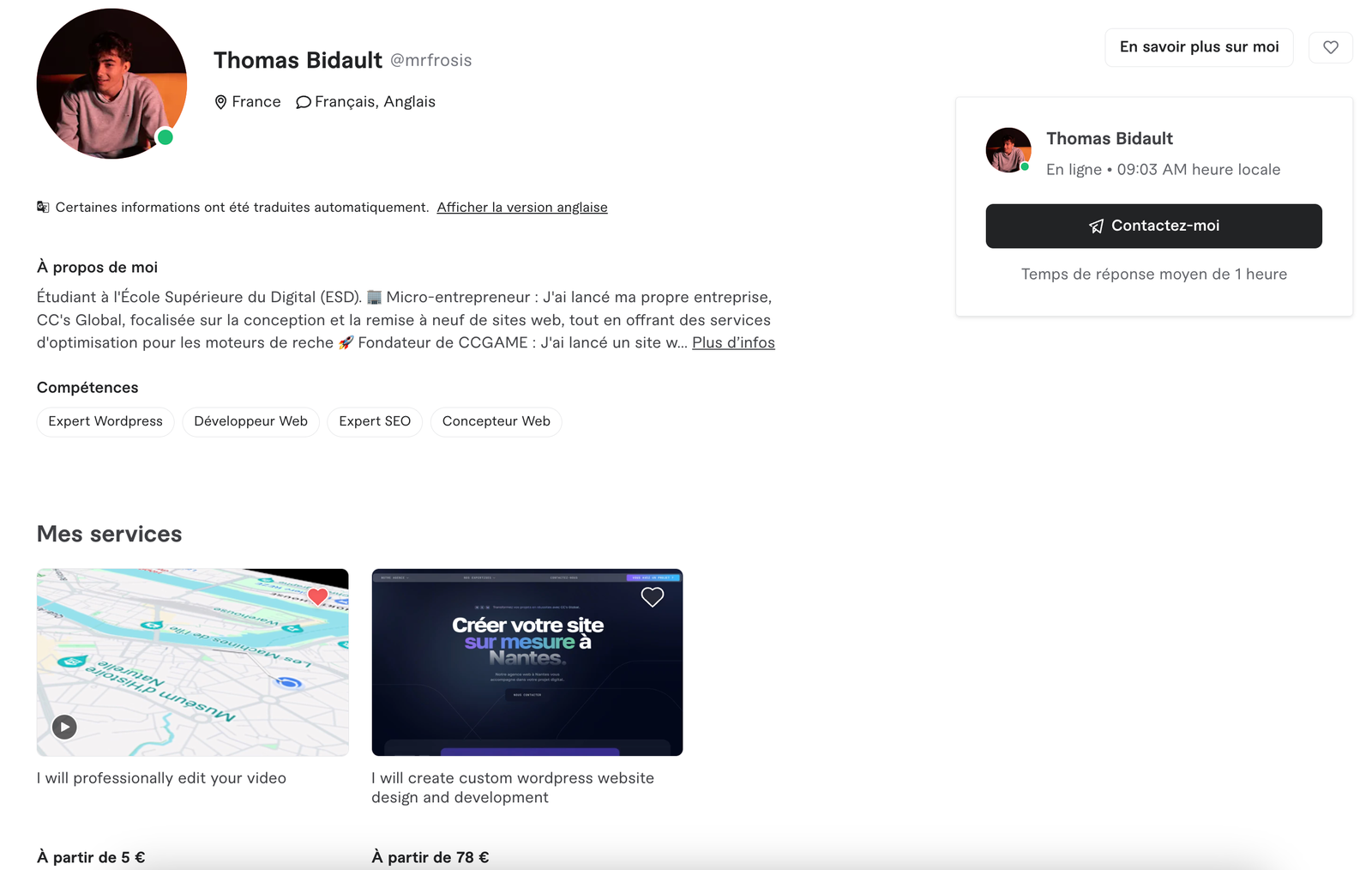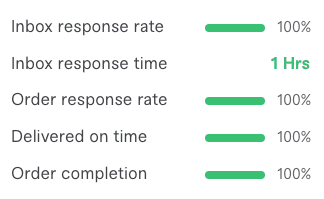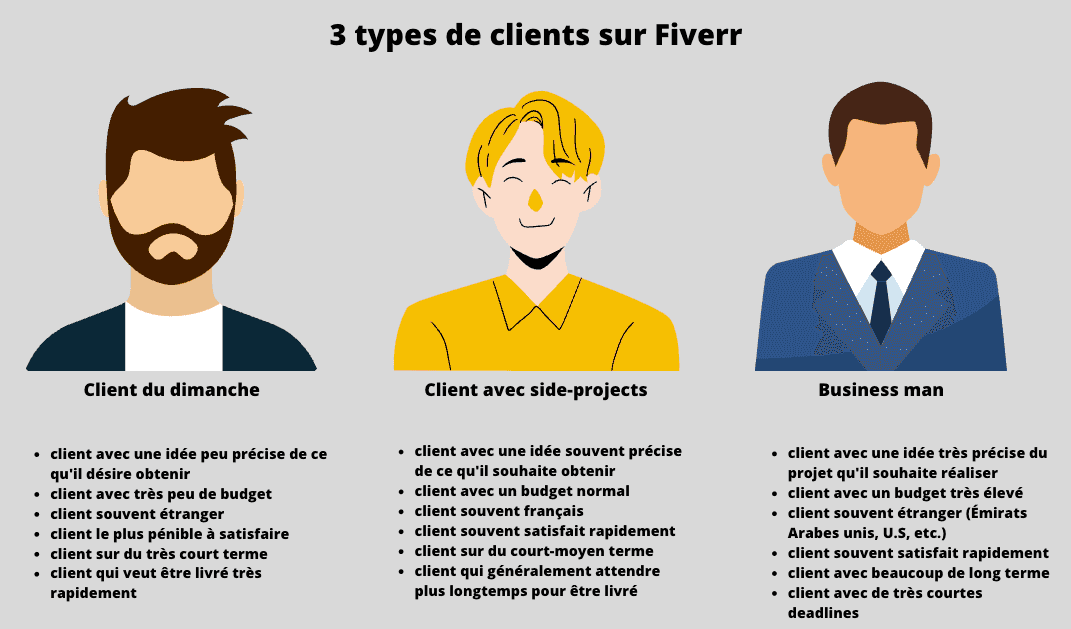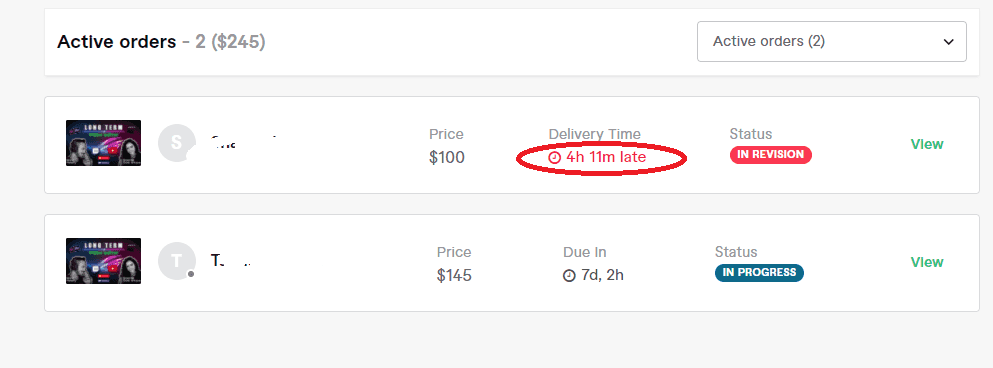Fiverr is a marketplace where you can buy the services of freelancers who specialise in a particular field. Over the last 14 months I’ve spent on the platform, I’ve discovered it and got to know it almost perfectly, to the point of obtaining the highest seller level on the platform and 130 exclusively positive reviews.
I’d like to take you back over this experience, which I think will be of interest to :
• buyers who are curious about the day-to-day lives of the freelancers who work for them
• new sellers who are reluctant to invest their time on Fiverr
• and… anyone else who’s curious 😉
I’m going to start by talking about Fiverr’s algorithm (metrics used, seller ranking, etc.), then talk about its direct consequences on a seller’s life (burn-out, fatigue, dependency, etc.), and conclude with my general opinion of the platform.



 That’s WHERE Fiverr gets interesting. It’s only at around 20 positive reviews that you can start thinking about refusing orders that pay too little or that don’t interest you, and selecting the best ones. A lot of people get stuck before that, trying to make a profit right from the start.
From this point on, you need to keep a few key ideas in mind, and you’ll be well on your way to success:
• never accept any order that you are not sure you can deliver.
• if a customer threatens to give you a bad star, do everything you can to satisfy them. You must keep a good rating on your profile at all costs. If you come across a recalcitrant customer, tough luck, you’re going to have to work harder; that’s how it is on Fiverr, the power of the rating they have is extremely strong. If they don’t accept your work, pay them back generously. It’s better to have wasted time than to stain your profile.
• Reply as quickly as you can to all your messages. On Fiverr, customers with large budgets are generally impatient and want everything they ask for straight away. From experience, the most profitable opportunities come from requests that are answered within the hour.
That’s WHERE Fiverr gets interesting. It’s only at around 20 positive reviews that you can start thinking about refusing orders that pay too little or that don’t interest you, and selecting the best ones. A lot of people get stuck before that, trying to make a profit right from the start.
From this point on, you need to keep a few key ideas in mind, and you’ll be well on your way to success:
• never accept any order that you are not sure you can deliver.
• if a customer threatens to give you a bad star, do everything you can to satisfy them. You must keep a good rating on your profile at all costs. If you come across a recalcitrant customer, tough luck, you’re going to have to work harder; that’s how it is on Fiverr, the power of the rating they have is extremely strong. If they don’t accept your work, pay them back generously. It’s better to have wasted time than to stain your profile.
• Reply as quickly as you can to all your messages. On Fiverr, customers with large budgets are generally impatient and want everything they ask for straight away. From experience, the most profitable opportunities come from requests that are answered within the hour.
 We can arrive at this simplified diagram. Sunday customers are the ones you get at the beginning, and then you move on to more and more business customers when you have a large number of reviews. They remain rare, and you need to place a lot of orders to find them.
Of course, there are also French customers on a budget who are very friendly and not in a hurry. They are simply not the majority of the types of customer on Fiverr described above.
We can arrive at this simplified diagram. Sunday customers are the ones you get at the beginning, and then you move on to more and more business customers when you have a large number of reviews. They remain rare, and you need to place a lot of orders to find them.
Of course, there are also French customers on a budget who are very friendly and not in a hurry. They are simply not the majority of the types of customer on Fiverr described above.
 As I explained earlier, high-paying opportunities generally require you to make a quick break in your schedule (sleep, spend time with friends, etc.). It’s a very trying rhythm to keep up.
After 2 months of placing orders one after the other, perfectly, and receiving dozens of positive reviews, I was starting to get very tired. This is the first time I’ve cancelled an order. I know perfectly well how to do what the customer wants me to do, and even if I’m paid €100 an hour, I can’t do it. The end of my weekend is approaching and I’ve got no energy left, I’m irritable, depressed, and I don’t have the strength to write all those lines of code after spending my weekend delivering, negotiating with customers, bending over backwards to get the maximum score.
As I explained earlier, high-paying opportunities generally require you to make a quick break in your schedule (sleep, spend time with friends, etc.). It’s a very trying rhythm to keep up.
After 2 months of placing orders one after the other, perfectly, and receiving dozens of positive reviews, I was starting to get very tired. This is the first time I’ve cancelled an order. I know perfectly well how to do what the customer wants me to do, and even if I’m paid €100 an hour, I can’t do it. The end of my weekend is approaching and I’ve got no energy left, I’m irritable, depressed, and I don’t have the strength to write all those lines of code after spending my weekend delivering, negotiating with customers, bending over backwards to get the maximum score.
 Maybe it’s just because I’m a student and have to do all this work in the evening or at weekends after a day at school, but I honestly think that this same problem applies to all Fiverr freelancers. When you work direct, if the client isn’t satisfied, they can in the worst case ask for a refund and open a dispute, but certainly not tarnish your reputation for all your future buyers. This extra pressure carries a lot of weight.
Maybe it’s just because I’m a student and have to do all this work in the evening or at weekends after a day at school, but I honestly think that this same problem applies to all Fiverr freelancers. When you work direct, if the client isn’t satisfied, they can in the worst case ask for a refund and open a dispute, but certainly not tarnish your reputation for all your future buyers. This extra pressure carries a lot of weight.


How do you satisfy the Fiverr algorithm?
Let’s start with the basics. How does the platform work? Fiverr’s algorithm works simply. When a buyer types ‘logo’ into Fiverr, the platform wants : • find a seller quickly • to be satisfied with their logo purchase from the seller (assessed by the rating, repeat purchases from the same seller) • not to cancel the order • they are delivered on time • that they spend as much as possible (i.e. their entire budget, or even a little more). So, as a seller, the platform determines : • an average response time • an average buyer satisfaction score • a ‘Repeat Business’ score • an order cancellation rate • a late delivery rate • an average selling price These criteria, together with the age of your account, are used to determine your overall ranking in searches, and your Fiverr level (beginner seller, level 1, level 2 or best seller).
Getting started by working for free
At the beginning, the platform will make you appear for clients with low or even very low budgets. And that’s when you have to make sacrifices that will be useful in the future. There’s only one watchword for new sellers: accept all the orders you can handle and turn a blind eye to the price. It doesn’t matter if you work for free. In the beginning, you’ll work a lot and earn very little (over a good month). You’re not working for free, you’re working for your profile and your ranking. Start making a profit Once you’ve managed to reach around 20 positive reviews on your profile (without any negative reviews…), you’ve just reached a major milestone on your road to profitability on Fiverr. You’re starting to be contacted by interesting customers who are very different from those you’ve met so far and who have serious plans. Unlike the customers who wanted the moon for £5 when you launched your profile, these customers are more respectful, have more realistic ambitions, more budget… more professional, in short. The most active customers with a ‘Fiverr Select’ badge start to contact you, and you unlock access to advertising on Fiverr.
 That’s WHERE Fiverr gets interesting. It’s only at around 20 positive reviews that you can start thinking about refusing orders that pay too little or that don’t interest you, and selecting the best ones. A lot of people get stuck before that, trying to make a profit right from the start.
From this point on, you need to keep a few key ideas in mind, and you’ll be well on your way to success:
• never accept any order that you are not sure you can deliver.
• if a customer threatens to give you a bad star, do everything you can to satisfy them. You must keep a good rating on your profile at all costs. If you come across a recalcitrant customer, tough luck, you’re going to have to work harder; that’s how it is on Fiverr, the power of the rating they have is extremely strong. If they don’t accept your work, pay them back generously. It’s better to have wasted time than to stain your profile.
• Reply as quickly as you can to all your messages. On Fiverr, customers with large budgets are generally impatient and want everything they ask for straight away. From experience, the most profitable opportunities come from requests that are answered within the hour.
That’s WHERE Fiverr gets interesting. It’s only at around 20 positive reviews that you can start thinking about refusing orders that pay too little or that don’t interest you, and selecting the best ones. A lot of people get stuck before that, trying to make a profit right from the start.
From this point on, you need to keep a few key ideas in mind, and you’ll be well on your way to success:
• never accept any order that you are not sure you can deliver.
• if a customer threatens to give you a bad star, do everything you can to satisfy them. You must keep a good rating on your profile at all costs. If you come across a recalcitrant customer, tough luck, you’re going to have to work harder; that’s how it is on Fiverr, the power of the rating they have is extremely strong. If they don’t accept your work, pay them back generously. It’s better to have wasted time than to stain your profile.
• Reply as quickly as you can to all your messages. On Fiverr, customers with large budgets are generally impatient and want everything they ask for straight away. From experience, the most profitable opportunities come from requests that are answered within the hour.
The world of sellers on Fiverr
I’m now going to talk about my personal experience with Fiverr, the backstage, and how I’ve lived these last 14 months. The stress of opportunities As a student, I didn’t have any particularly high expectations. I launched myself on the platform as a developer to give it a try, and I quickly got hooked. In the first month, I spent most of my evenings there, working flat out, and I completed 20 orders for around €1,071. In theory, that would be around €50 per order. But here… that’s absolutely not the case. The median price per order is around €25. Why is that? In the first month, a buyer contacted me and said he was prepared to pay €500 for a fairly simple project for what I was used to doing, if it was delivered within 24 hours. I agreed. And so I achieved 50% of my September 2021 turnover in one day. And this example shows a key feature of the platform: all the customers have completely different budgets, so much so that in one year I’ve sold an hour of my work for between €5 and €750. The second important point is that the highest-paying clients on Fiverr generally want everything, right away. It’s crazy, but a night’s work over 5-6 hours for a wealthy client in a hurry can earn you more than dozens of hours spent working for average clients. Because the ‘I want everything in 24 hours’ constraint can allow you to charge a lot of money, and foreign clients sometimes have no budget limit. In my opinion, this is what makes the platform addictive. Being a seller on Fiverr means taking one ‘normal’ order after another until you find THE customer of the week, a wealthy businessman from a foreign country who will allow you to make €2-3k in a few days on caffeine, or a month’s turnover with normal orders. A customer who would be impossible to find outside the platform. Another example: in April 2022, I was able to deliver a large rush order from a Californian in less than ten hours, which still represents 20% of the total turnover I’ve achieved on Fiverr since the start. When I say time lag, I’m not exaggerating. We can arrive at this simplified diagram. Sunday customers are the ones you get at the beginning, and then you move on to more and more business customers when you have a large number of reviews. They remain rare, and you need to place a lot of orders to find them.
Of course, there are also French customers on a budget who are very friendly and not in a hurry. They are simply not the majority of the types of customer on Fiverr described above.
We can arrive at this simplified diagram. Sunday customers are the ones you get at the beginning, and then you move on to more and more business customers when you have a large number of reviews. They remain rare, and you need to place a lot of orders to find them.
Of course, there are also French customers on a budget who are very friendly and not in a hurry. They are simply not the majority of the types of customer on Fiverr described above.
Burn out, a necessary step?
The pressure generated by Fiverr is by no means negligible. Messages pile up quickly and you always have to be available to respond. Orders also pile up very quickly, with lots of different customers on the platform and lots of different projects. The timer for the time remaining before delivery is displayed in large type, you have to deliver everything on time, there’s no room for error, the algorithm won’t let that go. As I explained earlier, high-paying opportunities generally require you to make a quick break in your schedule (sleep, spend time with friends, etc.). It’s a very trying rhythm to keep up.
After 2 months of placing orders one after the other, perfectly, and receiving dozens of positive reviews, I was starting to get very tired. This is the first time I’ve cancelled an order. I know perfectly well how to do what the customer wants me to do, and even if I’m paid €100 an hour, I can’t do it. The end of my weekend is approaching and I’ve got no energy left, I’m irritable, depressed, and I don’t have the strength to write all those lines of code after spending my weekend delivering, negotiating with customers, bending over backwards to get the maximum score.
As I explained earlier, high-paying opportunities generally require you to make a quick break in your schedule (sleep, spend time with friends, etc.). It’s a very trying rhythm to keep up.
After 2 months of placing orders one after the other, perfectly, and receiving dozens of positive reviews, I was starting to get very tired. This is the first time I’ve cancelled an order. I know perfectly well how to do what the customer wants me to do, and even if I’m paid €100 an hour, I can’t do it. The end of my weekend is approaching and I’ve got no energy left, I’m irritable, depressed, and I don’t have the strength to write all those lines of code after spending my weekend delivering, negotiating with customers, bending over backwards to get the maximum score.
 Maybe it’s just because I’m a student and have to do all this work in the evening or at weekends after a day at school, but I honestly think that this same problem applies to all Fiverr freelancers. When you work direct, if the client isn’t satisfied, they can in the worst case ask for a refund and open a dispute, but certainly not tarnish your reputation for all your future buyers. This extra pressure carries a lot of weight.
Maybe it’s just because I’m a student and have to do all this work in the evening or at weekends after a day at school, but I honestly think that this same problem applies to all Fiverr freelancers. When you work direct, if the client isn’t satisfied, they can in the worst case ask for a refund and open a dispute, but certainly not tarnish your reputation for all your future buyers. This extra pressure carries a lot of weight.
The unavailable mode… essential
So December was a very quiet month for me, during which I became aware of all this, and which allowed me to recover… only to pick up again in January. I miss the Fiverr dopamine and I’m happy to be working with new clients on new projects. However, I’m not making the same mistake I did at the beginning: I’m activating the unavailable mode as soon as I have to deliver more than 2-3 orders. I’m no longer bothered by new requests, and I can concentrate fully on what I still have to deliver.
No risk-taking tolerated
A number of my friends have asked me whether it’s a good idea to use Fiverr to learn a new technology for a fee. In other words, a client is going to ask me to design a website or a logo, and I’m going to use the opportunity to train myself and then deliver. And to that I’d say that if you’re really looking for profitability… don’t do it. The platform encourages you not to accept any order that you’re not sure you can fulfil. If there’s one thing it punishes more severely than a click that doesn’t lead to an order, it’s a click that leads to a cancelled order. What’s more, it’s also a risk of obtaining a negative rating on your profile, which will scare off future buyers. So, accept as many orders as possible, but only those that you have already placed in the past, and that you are perfectly certain you can deliver.Heavy taxes
It’s hard to talk about Fiverr without mentioning the taxes levied on each mission (20%). It’s quite substantial. I paid several thousand euros to Fiverr over the year. It’s crazy from a technical point of view, 20% for a referral… but as a seller, it’s obviously worth it. Fiverr allows me to find customers that I can charge 50-100% more for than through my personal network.An obvious dependency on Fiverr
A subject that seems more important to me, however, is the fact that you depend on the platform to contact your network. I’ve already been banned from the platform by mistake at the beginning of January, and I realise just how dependent I am on the platform to generate my turnover. When a customer requests it, I send them an invoice directly (to stay within Fiverr’s T.O.S., you mustn’t offer not to pay via the platform yourself). This gives me a network outside Fiverr in case my account is no longer available one day.Conclusion
To sum up, Fiverr is an interesting platform for sellers because it allows you to : • start from scratch, with no prior network, just skills • you don’t have to waste time convincing the buyer of your skills • all your opinions are recorded on your profile • work with clients from all over the world, on many different projects • work with clients who offer much higher than normal remuneration, the ‘Fiverr Select’. …but at the same time : • requires constant availability to respond to requests, so as not to miss out on the occasional ‘Fiverr Select’ opportunity • creates enormous pressure, particularly on the ratings left by customers • a high level of dependency on the platform on which your entire network is based. If you want to start out as a seller : • work (almost) free of charge before the first 20 reviews, race for 5 stars • don’t play with fire, and don’t accept any orders where there is a risk of you cancelling them • focus on positive reviews and ratings, making them a priority • don’t hesitate to use the unavailable mode when you’re overbooked. Fiverr is a tiring and stressful platform to work on, and it’s easy to get caught up in it.This article is as brief a summary of my experience as possible, but there are obviously a lot of details I haven’t been able to cover. If you have any questions, don’t hesitate to ask me on Twitter!
